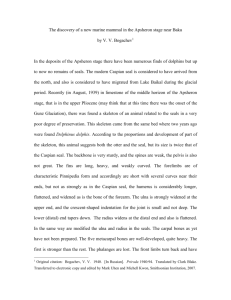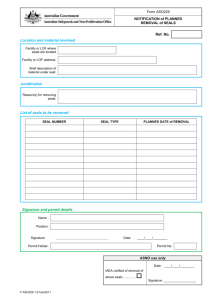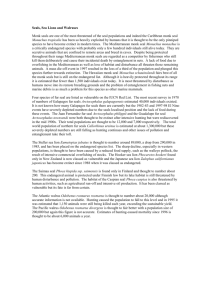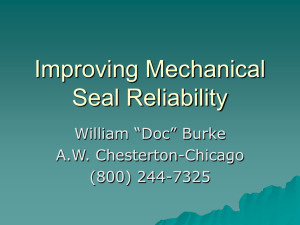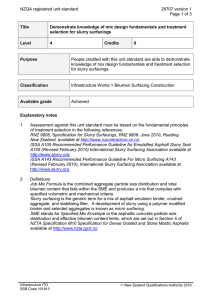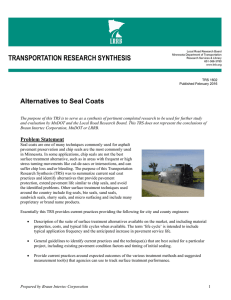15Q2-E3-1 - Nevada Department of Transportation
advertisement
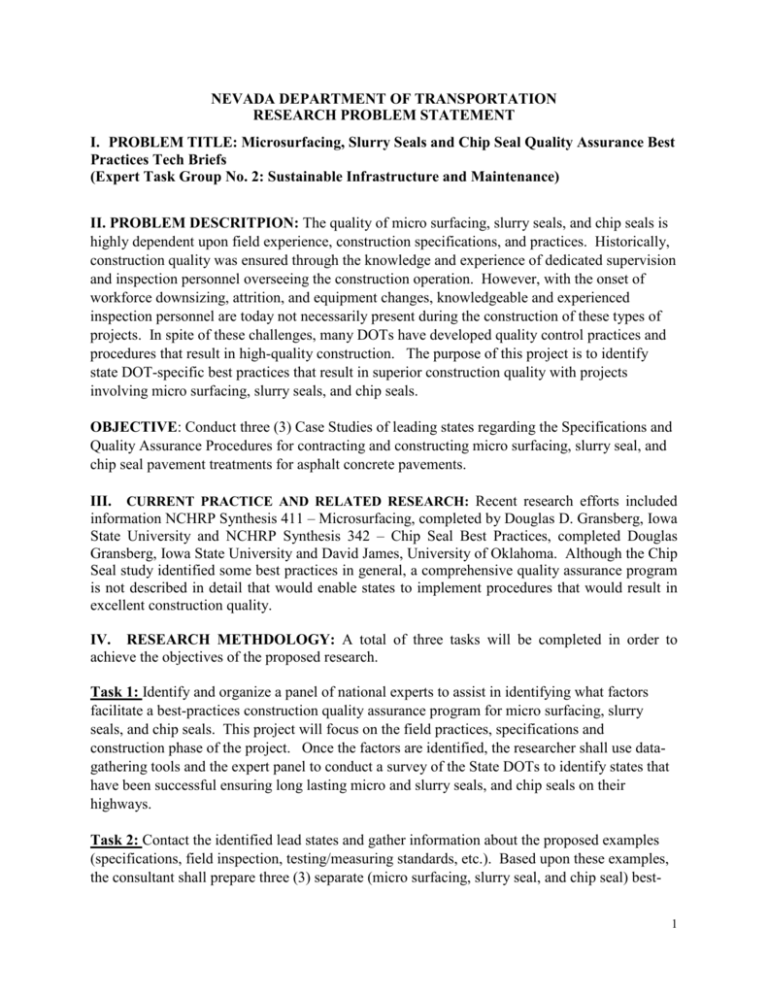
NEVADA DEPARTMENT OF TRANSPORTATION RESEARCH PROBLEM STATEMENT I. PROBLEM TITLE: Microsurfacing, Slurry Seals and Chip Seal Quality Assurance Best Practices Tech Briefs (Expert Task Group No. 2: Sustainable Infrastructure and Maintenance) II. PROBLEM DESCRITPION: The quality of micro surfacing, slurry seals, and chip seals is highly dependent upon field experience, construction specifications, and practices. Historically, construction quality was ensured through the knowledge and experience of dedicated supervision and inspection personnel overseeing the construction operation. However, with the onset of workforce downsizing, attrition, and equipment changes, knowledgeable and experienced inspection personnel are today not necessarily present during the construction of these types of projects. In spite of these challenges, many DOTs have developed quality control practices and procedures that result in high-quality construction. The purpose of this project is to identify state DOT-specific best practices that result in superior construction quality with projects involving micro surfacing, slurry seals, and chip seals. OBJECTIVE: Conduct three (3) Case Studies of leading states regarding the Specifications and Quality Assurance Procedures for contracting and constructing micro surfacing, slurry seal, and chip seal pavement treatments for asphalt concrete pavements. III. CURRENT PRACTICE AND RELATED RESEARCH: Recent research efforts included information NCHRP Synthesis 411 – Microsurfacing, completed by Douglas D. Gransberg, Iowa State University and NCHRP Synthesis 342 – Chip Seal Best Practices, completed Douglas Gransberg, Iowa State University and David James, University of Oklahoma. Although the Chip Seal study identified some best practices in general, a comprehensive quality assurance program is not described in detail that would enable states to implement procedures that would result in excellent construction quality. IV. RESEARCH METHDOLOGY: A total of three tasks will be completed in order to achieve the objectives of the proposed research. Task 1: Identify and organize a panel of national experts to assist in identifying what factors facilitate a best-practices construction quality assurance program for micro surfacing, slurry seals, and chip seals. This project will focus on the field practices, specifications and construction phase of the project. Once the factors are identified, the researcher shall use datagathering tools and the expert panel to conduct a survey of the State DOTs to identify states that have been successful ensuring long lasting micro and slurry seals, and chip seals on their highways. Task 2: Contact the identified lead states and gather information about the proposed examples (specifications, field inspection, testing/measuring standards, etc.). Based upon these examples, the consultant shall prepare three (3) separate (micro surfacing, slurry seal, and chip seal) best1 practice technology briefs presenting the best practices of construction quality assurance. The national expert panel shall be used to assist in reviewing and finalizing the technology briefs. Task 3: Develop the final deliverables. These shall include three (3) technology briefs with accompanying appendices, example specifications, testing/measuring practices, and other information critical to the project goals as determined by the expert pane, in an electronic format that is accessible to those with disabilities (Section 508 of the Workforce Rehabilitation Act). The consultant shall prepare delivery and provide a PowerPoint presentation regarding the finding of the research. An electronic copy of all documents shall be provided to Nevada DOT and FHWA for national dissemination and use as they so see fit to use the intellectual knowledge and deliverables. V. IMPLEMENTATION POTENTIAL: The combination of technical briefs and PowerPoint presentations will make the three major deliverables ready for immediate implementation into state highway agency current practices. No institutional, political, or socio-economic barriers are expected. VI. URGENCY AND PAYOFF POTENTIAL: Many states have reported poor quality and premature failure of recent microsurfacing, slurry and chip seal treatments. Poorly constructed pavement surface seals result in premature pavement failures. The cost of these treatments are essentially wasted when they are not properly constructed. State of the art specifications and quality control and quality assurance practices can ensure good quality products on the road that can extend pavement life and enhance ride safety. VII. ESTIMATED BUDGET: The duration of the proposed research effort will be for one years at the total cost of $150,000. VIII. DATE AND SUBMITTED BY: May 13, 2015 Ms. Anita Bush, Chief Maintenance Engineer, NDOT Maintenance Division, Phone: 775-8887856, email: Abush@dot.state.nv.us IX. NDOT CHAMPION, COORDINATION AND INVOLVEMENT: Ms. Anita Bush, Chief Maintenance Engineer, NDOT Maintenance Division, Phone: 775-8887856, email: Abush@dot.state.nv.us OTHER AGENCIES, COORDINATION AND INVOLVEMENT Mr. Bryan Cawley, Construction Management Team Leader, FHWA, Phone: 202-366-1333, email: Bryan.Cawley@dot.gov AASHTO Subcommittee on Maintenance Pavement Technical Working Group 2
